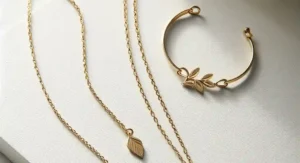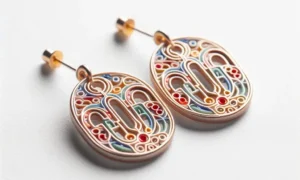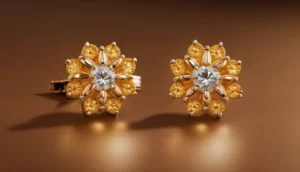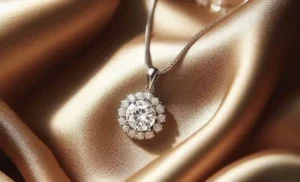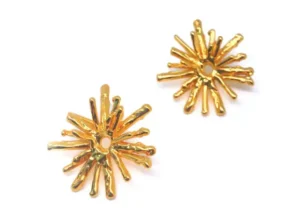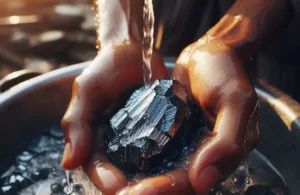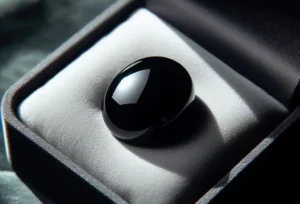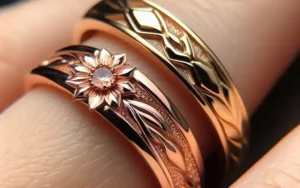Black tourmaline is a popular and powerful crystal known for its ability to protect against negative energy and promote grounding and balance.
If you’re looking to purchase authentic black tourmaline, it’s important to know how to distinguish between real and fake stones.
In this blog post, we’ll share some tips on how to identify genuine black tourmaline and ensure you’re getting the real deal.
How to Tell If Black Tourmaline Is Real?

– Inspect for natural striations: Look for the characteristic parallel lines on the stone’s surface, indicative of genuine black tourmaline.
– Assess weight and feel: Authentic black tourmaline has a notable heft due to its dense mineral composition, distinguishing it from lighter, synthetic imitations.
– Check the luster: Real black tourmaline exhibits a glass-like sheen, unlike the artificial gloss seen on fake stones.
– Observe for imperfections: Genuine stones will have natural variations and imperfections, contrasting with the uniform appearance of manufactured ones.
– Perform a heat test: Rub the stone to warm it and then see if it attracts light materials like paper, indicating its pyroelectric property—a unique feature of real black tourmaline.
– UV light test: Authentic black tourmaline does not fluoresce under UV light, so a lack of glow can suggest the stone’s authenticity.
– Consider professional verification: If in doubt, consulting with a certified gemologist or using a gem tester can provide further assurance of the stone’s genuineness.
Understanding Black Tourmaline’s Unique Characteristics

Black tourmaline, often referred to by its mineral name schorl, captivates with its deep, obsidian hue, occasionally revealing a captivating sheen when subjected to direct light. This gemstone is renowned not only for its aesthetic appeal but also for its structural and compositional qualities that set it apart from imitations.
Its natural formation results in a crystalline structure marked by striations – parallel lines that run along its surface, a characteristic seldom found in counterfeit materials. This attribute is intrinsic to its identity, offering a tactile and visual clue to its authenticity.
Additionally, black tourmaline exhibits a certain heft, a direct reflection of its dense mineral makeup, which contributes to its substantial feel when held. This density, coupled with its hardness rating of 7-7.5 on the Mohs scale, underscores its durability and resistance to everyday wear, distinguishing it from softer or more brittle faux alternatives.
These unique characteristics—striations, heft, and hardness—are key indicators of black tourmaline’s genuine nature, allowing enthusiasts and collectors to appreciate not only its external beauty but also its inherent physical and mineralogical properties.
Conduct a Visual and Physical Inspection
Initiate your inspection by focusing on the stone’s surface, where the presence of natural striations should be apparent. These linear marks are a signature trait of authentic black tourmaline and serve as a primary identifier. Pay attention to the weightiness of the stone in your hand; genuine black tourmaline possesses a surprising heft relative to its size due to its dense mineral structure.
Another aspect to examine is the luster of the stone. Authentic pieces will display a glass-like sheen, distinctly different from the artificial gloss of plastic imitations. During your inspection, it’s crucial to note the irregularities and imperfections inherent to natural stones.
Unlike manufactured counterparts, which often boast an unnerving uniformity and flawless appearance, real black tourmaline will have natural variations in shape and texture. Additionally, the coolness of the stone upon touch further corroborates its authenticity. Synthetic materials or imitations rarely mimic this characteristic temperature effectively.
When inspecting for these features, remember that a combination of these observations contributes to a more reliable assessment of the stone’s authenticity, guiding you toward discerning genuine black tourmaline from its counterfeits.
Test the Stone’s Electrical Conductivity
Black tourmaline stands out in the gem world due to its pyroelectric capabilities, a phenomenon where it becomes electrically charged under the influence of heat. To leverage this property for authenticity testing, you can gently warm the stone by rubbing it between your hands.
Once sufficiently heated, bring it close to lightweight materials such as small shreds of paper or dust particles. If the stone attracts these items, it’s demonstrating its pyroelectric effect, a hallmark of genuine black tourmaline. This experiment taps into one of the more distinctive qualities of the stone, yet it’s crucial to approach this test with care.
Excessive rubbing might damage the stone or affect its natural state. Remember, while this method offers a unique way to verify authenticity, it’s just one of several techniques to consider. Depending on your situation, you might find other methods more practical or accessible.
Nonetheless, the ability of black tourmaline to exhibit electrical conductivity under heat is a fascinating aspect of its natural properties and, when observed, can serve as a compelling indication of the stone’s authenticity.
Check for UV Reactivity
Exploring the reaction of black tourmaline under ultraviolet (UV) light offers an intriguing method to assess its authenticity. Unlike many minerals and synthetic materials, authentic black tourmaline typically remains inert and does not fluoresce under UV light.
This characteristic is a direct contrast to several common counterfeit substances, which may exhibit a noticeable glow when exposed to such lighting conditions. To conduct this test, simply shine a UV light on the stone in question and observe any luminescent response.
The absence of fluorescence suggests the stone’s legitimacy as genuine black tourmaline. However, it’s essential to note that while this test can be indicative, it should not be the sole criterion for determining authenticity.
Different materials and treatments can affect the outcome, and some genuine stones may have unique inclusions or characteristics leading to unexpected reactions.
Therefore, employing this method alongside other authenticity checks enhances the reliability of your assessment. It’s a fascinating and accessible test that adds an additional layer of verification to your evaluation process, helping to identify authentic black tourmaline amidst a sea of imitations.
Consult with a Gemologist or Use a Gem Tester
When the authenticity of black tourmaline remains in question despite employing various tests, seeking expertise from a certified gemologist emerges as a prudent step. These specialists leverage sophisticated instruments and their extensive knowledge of gemstones to render a precise verdict on the nature of your specimen.
This approach can be particularly beneficial for those dealing with high-value pieces or when assembling a collection where authenticity is paramount.
Alternatively, the utilization of a gem tester represents a more accessible, albeit potentially less definitive, method to gauge the stone’s authenticity. While these devices can offer immediate insights based on the thermal conductivity and other properties of the stone, it’s important to recognize their limitations.
Certain gem testers might not be finely calibrated to distinguish between black tourmaline and materials with similar physical characteristics. Therefore, while helpful, a gem tester should be considered a supplementary tool rather than a definitive solution.
In either case, whether opting for the expertise of a gemologist or the convenience of a gem tester, these strategies enhance your ability to discern genuine black tourmaline, contributing to the informed curation of your collection. This careful vetting process underscores the dedication to preserving the integrity and value of your gemstone investments.
Understand Common Imitations and Their Characteristics
Navigating the world of gemstones requires an astute awareness of the materials frequently used to mimic black tourmaline’s distinctive appearance. Among the most common impostors are black glass and obsidian, as well as various minerals that have been artificially dyed to replicate the deep black hue of genuine tourmaline.
These substitutes, while sometimes convincing at a glance, typically fall short under closer scrutiny. Black glass, for instance, lacks the natural inclusions and striations that characterize real black tourmaline, often revealing a smoother, more uniform surface that betrays its artificial origin.
Obsidian, a natural volcanic glass, may mimic the lustre of black tourmaline but does not exhibit the same hardness or characteristic striations, making it a less convincing substitute upon examination.
Dyed minerals, on the other hand, may temporarily deceive with their colour, but often the dye can be detected around cracks, crevices, or when the stone is viewed under magnification, revealing uneven colour distribution or concentrations of colour that natural black tourmaline would not possess.
Each of these imitations, while offering visual appeal, fails to fully replicate the unique combination of physical and visual properties inherent to genuine black tourmaline, underscoring the importance of a keen eye in distinguishing the authentic from the counterfeit.
The Importance of Buying from Reputable Sellers
Navigating the gemstone market requires caution, particularly when seeking authentic black tourmaline. Engaging with reputable sellers is not just a strategy but a necessity to ensure the integrity of your collection. These sellers are distinguished by their commitment to transparency, offering clear documentation about the provenance and any treatments the stones may have undergone. This level of detail is crucial for collectors who value the authenticity and history of their gems.
Reputable dealers also maintain robust return policies, allowing buyers to feel secure in their purchases. This safety net is particularly important when investing in high-value items or when you’re new to collecting gemstones. It ensures that should any concerns about authenticity arise post-purchase, there is a recourse available to address these worries.
Moreover, these trusted sources often belong to professional associations that uphold strict ethical standards in the trade of gemstones. Membership in such organizations serves as a badge of trust, signaling that the dealer adheres to a code of conduct designed to protect the consumer.
Choosing to buy from well-established and credible sellers thus acts as a crucial layer of protection for both novice and experienced collectors alike. It guards against the pitfalls of counterfeit stones, securing both the aesthetic and metaphysical value that genuine black tourmaline brings to a collection.
By prioritizing authenticity and ethical sourcing, collectors can foster a more fulfilling and worry-free experience in their gemstone endeavors.
Incorporating Black Tourmaline into Your Collection
With your newfound skills in distinguishing authentic black tourmaline, integrating this enchanting stone into your collection becomes an exciting venture. Black tourmaline, celebrated for its protective qualities and grounding energy, enhances any gemstone ensemble, offering both visual allure and spiritual benefits.
When adding black tourmaline to your collection, consider its placement and companions. This gemstone pairs beautifully with crystals that amplify its protective attributes, such as clear quartz, or with stones that complement its grounding effect, like smoky quartz.
Think about how you will use these pieces—whether as part of a display, for personal wear, or for metaphysical practices. Each application can influence the shapes and sizes you choose, ensuring they align with your intentions. For instance, polished stones or jewelry pieces are ideal for daily wear, while raw, natural specimens might be better suited for an energy-focused space in your home.
Remember, the journey to building a meaningful collection is ongoing. As you continue to explore and learn, your ability to discern and appreciate the subtleties of black tourmaline will deepen. This process not only enriches your collection but also connects you more closely with the fascinating world of gemstones.
Embrace this journey with confidence, knowing that each authentic piece of black tourmaline you select is an investment in beauty, energy, and the enduring appeal of the natural world.


